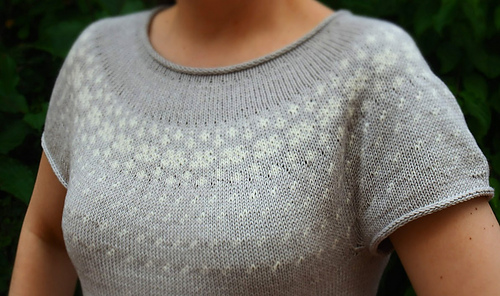patterns >  Woolen Tales' Ravelry Store
Woolen Tales' Ravelry Store
> Hanafubuki Top












Hanafubuki Top
Hanafubuki - 花吹雪
Petal rain: when a gust of wind makes many petals fall at once and they resemble a snowstorm.
One of the pleasures we cherish most at home is to stroll the paths that wind through the neighboring hills, in the typical Mediterranean forest. It is common to find oaks and holm oaks, alder trees, and hazelnut groves. However, in the fields surrounding an old farmhouse, stands a single and solitary cherry tree, which I have a special fondness for. Every spring we visit it, witness its blossoming and, when the time comes, we contemplate how the wind undresses its branches… a shower of petals carried by the wind with a fairy beauty that speaks of how ephemeral and treasurable life is.
In Japanese there is a wonderful word to describe this shower of petals: Hanafubuki. It is composed of hana 花 (flower) and fubuki 吹雪 (blizzard or snowstorm). It literally means “flower blizzard.” It names the phenomenon of a group of flowers falling together from the tree because of a gust of wind. Like a gale of flowers, hence the name hanafubuki or “flower blizzard”.
This beautiful Japanese word is closely related to the word Sakura, the Japanese word for “cherry tree”. The reason is that Hanafubuki is used especially to refer to the rain of Sakura petals caused by spring winds, which is quite a visual spectacle. The sakura kanji itself is one of the most beautiful characters in Japanese. It is composed of the tree radical 木, water drops 水 and woman 女.
Hanafubuki is a circular short sleeve yoke that is worked seamlessly from the top down. The neck is worked in plain stockinette, to form a nice rolling out edge, after that, several series of short rows are used for a comfortable and beautifully shaped finish.
The yoke is shaped with increases that are evenly distributed around the entire circumference of the upper body.
Sleeves are then placed on hold and the body is worked toward the hem. The sleeve stitches are then placed on the needles again and worked in the round toward the cuffs.
As the top is knitted top-down lengths are easily adaptable.
The lower edge of the body and the sleeves is finished with an i-cord bind-off.
Please note that the stranded pattern is charted only.
Sizes 1 (2, 3, 4, 5, 6, 7)
Bust circumference of the finished sweater: 78,5 (88, 97,5, 113,5, 123, 132,5, 138) cm / 31 (34 ¾, 38 ½, 44 ¾, 48 ½, 52 ¼, 54 ¼ )’’.
The sweater is designed to be worn with approximately 5 cm / 2’’ of positive ease.
Model has 85 cm / 33½’’ bust, stands 164 cm / 64½’’ and is wearing size 2.
Yarn
Sample is knitted in Cotton Cashmere by Katia Yarns (90% Cotton - 10% Cashmere) 50 gr / 1 oz. ¾ - 155 m / 169 yds.
Sample shown in 56 - Stone grey (MC ) 52 - White (CC)
MC: 4 (4, 4, 5, 5, 6, 6) skeins
CC: 1 (1, 1, 1, 1, 2, 2) skeins
Needles
2,5 mm / US 1½ circular needle 24”/60 cm or 32”/80 cm for the neck
3 mm / US 2½ circular needle 24”/60 cm or 32”/80 cm and 3 mm / US 2½ circular or dpns suitable for working small circumferences in the round (sleeves)
Notions
1 stitch marker • waste yarn for holding the sleeve stitches • tapestry needle to weave in the yarn ends
Gauge
25 sts and 35 rows - 10x10 cm / 4x4’’ in stockinette stitch with 3 mm / US 2½ needles, washed and blocked.
1898 projects
stashed
1428 times
- First published: August 2021
- Page created: August 24, 2021
- Last updated: August 24, 2021 …
- visits in the last 24 hours
- visitors right now





